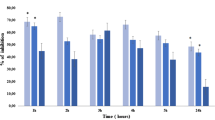Abstract
Pharmacological evaluation of alcoholic extract of salai guggal (AESG) has been carried out in experimental animals. AESG displayed marked anti-inflammatory activity in carrageenan induced oedema in rats and mice and dextran oedema in rats. It was equally effective in adrenalectomised rats. In formaldehyde and adjuvant arthritis, AESG produced prominent anti-arthritic activity but no significant effect was observed in cotton pellet-induced granuloma test. It inhibited inflammation induced increase in serum transaminase levels and leucocyte counts but lacked any analgesic or anti-pyretic effects. The gestation period or parturition time in pregnant rats or onset time of castor oil-induced diarrhoea was unaffected by AESG and no significant effect was seen on cardiovascular, respiratory and central nervous system functions. No ulcerogenic effects were found in the rat stomach. The oral and intraperitoneal LD50 was greater than 2 g/Kg in mice and rats.
Similar content being viewed by others
References
The Wealth of India. C.S.I.R. Publication. 1 Delhi, 208–210 (1948).
G.G. Bhargava, J.S. Negi andS.R.D. Ghua,Studies on the chemical composition of salai gum. Ind. Forester.104, 174–181 (1978).
Mrs R.S. Pardhy andS.C. Bhattacharyya.Structure of the serratol, a new diterpene cembranoid alcohol from Boswellia serrata Roxb. Ind. J. Chem.16B, 171–173 (1978).
Mrs R.S. Pardhy andS.C. Bhattacharyya.Tetracyclic triterpene acids from the resin of boswellia serrata Roxb. Ind. J. Chem.16B, 174–175 (1978).
Mrs R.S. Pardhy andS.C. Bhattacharyya.-boswellic acid, acetyl-boswellic acid and 11-keto-boswellic acid, four pentacyclic triterpene acids from the resin of boswellia serrata Roxb. Ind. J. Chem.16B, 176–178 (1978).
A. Kumar andV.K. Saxena.TLC and GLC studies of the essential oil from Boswellia serrata leaves. Ind. Drugs.16, 80–83 (1979).
M.K. Menon andA. Kar.Analgesic and Psychopharmacological effects of the gum resin of Boswellia serrata.Planta Medica 19, 333–341 (1971).
C.A. Winter, E.A. Risley andG.W. Nuss.Carrageenan induced oedema in hind paw of the rat as an assay for antiinflammatory drugs. Proc. Soc. Exp. Biol. Med.111, 544–547 (1962).
C.A. Winter,Anti-inflammatory testing methods: Comparative evaluation of indomethacin and other agents. In: International Symposium on ‘Non-steroidal antiinflammatory drugs’, 190–202 (1964).
P. Schultzer,Mortality of adrenalectomised young rats, with improved technique of operation after a period of treatment with cortical hormone. J. Physiol. (Lond.)84, 70–82 (1935).
R.C. Srimal andB.N. Dhawan.On the solubility of mice as an experimental animal for study of anti-inflammatory agents. Ind. J. Pharmac.3, 4 (1971).
H. Selye,Further studies concerning the participation of the adrenal cortex in the pathogenesis of arthritis. Brit. M. J2, 1129–1135 (1949).
C.A. Winter andC.C. Porter.Effect of alterations in side chain upon anti-inflammatory and liver glycogen activities of hydrocortisone esters. J. Amer. Pharm. Ass. Sci Ed.46, 515–519 (1957).
B.B. Newbould.Chemotherapy of arthritis induced in rats by mycobacterial adjuvant. Br. J. Pharmacol.21, 127–136 (1963).
B.B. Newbould.The pharmacology of fenclozic acid (2-(4-chlorophenyl)-thiazol-4-ylactic acid: I.C.I.54, 450;‘Myales’; a new compound with anti-inflammatory activity. Br. J. Pharmacol.35, 487–497 (1969).
A.P. Hanson.Quoted in Methods of enzymatic analysis p-842 (1959). (Ed)H.U. Bergmeyer. London. Academic Press (1963).
J. Thuilleir, P. Bessin, F. Geoffroy andJ. Godfroid.Chimic et pharmacologie de la clofezone. Chim. Ther.3, 53–67 (1968).
L.B. Witkin, C.F. Heubner, F. Galdi, E. O'Keefe, P. Spitaletta andA.J. Plummer.Pharmacology of 2-amino-indane hydrochloride (Su-8629): a potent nonnarcotic analgetic. J. Pharmacol. Exp. Ther.133, 400–408 (1961).
C. Bianchi andA. David.Analgesic properties of 4-ethoxycarbonyl-1-1-(2-hydroxy-3-phenoxypropyl)4-phenylpiperadine (B.D.H. 200) and some related compounds. J. Pharm. Pharmac.12, 449–459 (1960).
G. Brownles.A comparison on the antipyretic activity and toxicity of phenactin and aspirin. J. Pharm. Pharmac.10, 609 (1937).
J.H. Burn, D.J. Finney andL.G. Goodwin.Biological Standardization. Oxford University Press. 177–193 (1950).
G.B. Singh, R.C. Srimal andB.N. Dhawan.Pharmacological studies on 3-[-(p-fluorobenzoyl)propyl]-2,3,4,4a,5,6 hexahydro-1-(H)-pyrazino (1,2-a) quinoline hydrochloride (compound 69/183) part III. Arzneim.-Forsch.Drug Res.28, 1403–1406 (1978).
G.B. Singh, R.C. Srimal, S. Nityanand andB.N. Dhawan.Pharmacological studies on 3-[-(p-fluorobenzoyl propyl]-2,3,4,4a,5,6-hexahydro-1(H)-pyrazino (1, 2-a) quinoline compound 69/183) Part I. Arzneim.-Forsch./Drug Res.28, 1087–1091 (1978).
J.W. Aiken.Aspirin and indomethacin prolong parturition in rats: evidence that prostaglandins contribute to expulsion of foetus. Nature (Lond.), 201–21 50 (1972).
F. Awouters, C.J.E. Niemegeers, F.M. Lenaerts andP.A.J. Janssen.Delay of castor oil diarrhoea in rats: a new way to evaluate inhibitors of Prostaglandin biosynthesis. J. Pharm. Pharmac.30 41–45 (1978).
S.H. Ferreira andJ.R. Vane.Mode of action of anti-inflammatory agents which are prostaglandin synthetase inhibitors. InJ.R. Vane andS.H. Ferreira. (Eds). Handbook of Experimental Pharmacology 50/II. Springer-Verlag Berlin Heidelberg New York, 348–398 (1979).
M.Di. Rosa.Inhibition of cell migration in vivoand granuloma formation. InJ.R. Vane andS.H. Ferreira. (Eds). Handbook of Experimental Pharmacology: 50/II. Springer-Verlag, Berlin Heidelberg New York 223–254 (1979).
A. Robert.Prostaglandins, 6 523–532 (1974).
Z.N. Gaut, H. Baruth, L.O. Randall, C. Ashley andJ.R. Paulsrud.Prostaglandins.10, 59–66 (1975).
C.H. Cashin, W. Dawson andE.A. Kitchen.The pharmacology of benzoxaprofen (2-[4-chlorophenyl]-methyl-5-benzoxazola acetic acid), LRCL 3794, a new compound with anti-inflammatory activity apparently unrelated to inhibition of Prostaglandin synthesis. J. Pharm. Pharmac.29, 330–336 (1977).
J.R. Vane.Inhibition of prostaglandin synthesis as a mechanism of action for aspirin-like drugs.Nature (New Biol.) 231, 232–235 (1971).
J.W. Aiken.Prostaglandins and prostaglandin synthetase inhibitors: studies on uterine motility and function. InH.J. Robinson, andJ.R. Vane (Eds). Prostaglandin Synthetase Inhibitors. Raven Press, New York, 289–301 (1974).
K.I. Williams andJ.R. Vane.Inhibition of uterine motility: the possible role of prostaglandins and aspirin like drugs. Pharmacol. Ther. B.1, 89–113 (1975).
Author information
Authors and Affiliations
Rights and permissions
About this article
Cite this article
Singh, G.B., Atal, C.K. Pharmacology of an extract of salai guggal ex-Boswellia serrata, a new non-steroidal anti-inflammatory agent. Agents and Actions 18, 407–412 (1986). https://doi.org/10.1007/BF01965005
Received:
Accepted:
Issue Date:
DOI: https://doi.org/10.1007/BF01965005




